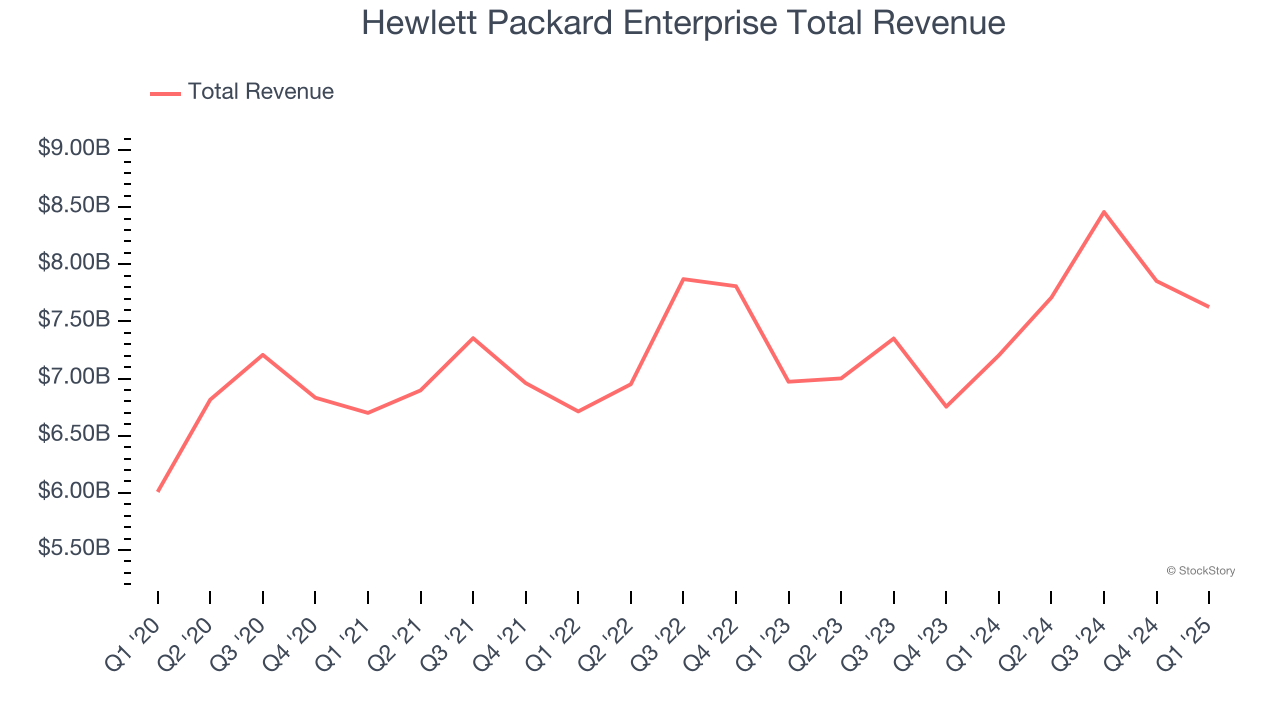
The end of the earnings season is always a good time to take a step back and see who shined (and who not so much). Let’s take a look at how hardware & infrastructure stocks fared in Q1, starting with HP (NYSE:HPQ).
The Hardware & Infrastructure sector will be buoyed by demand related to AI adoption, cloud computing expansion, and the need for more efficient data storage and processing solutions. Companies with tech offerings such as servers, switches, and storage solutions are well-positioned in our new hybrid working and IT world. On the other hand, headwinds include ongoing supply chain disruptions, rising component costs, and intensifying competition from cloud-native and hyperscale providers reducing reliance on traditional hardware. Additionally, regulatory scrutiny over data sovereignty, cybersecurity standards, and environmental sustainability in hardware manufacturing could increase compliance costs.
The 9 hardware & infrastructure stocks we track reported a slower Q1. As a group, revenues were in line with analysts’ consensus estimates while next quarter’s revenue guidance was 0.7% above.
Luckily, hardware & infrastructure stocks have performed well with share prices up 11.4% on average since the latest earnings results.
Weakest Q1: HP (NYSE:HPQ)
Born from the legendary Silicon Valley garage startup founded by Bill Hewlett and Dave Packard in 1939, HP (NYSE:HPQ) designs and sells personal computers, printers, and related technology products and services to consumers, businesses, and enterprises worldwide.
HP reported revenues of $13.22 billion, up 3.3% year on year. This print exceeded analysts’ expectations by 0.9%. Despite the top-line beat, it was still a disappointing quarter for the company with a significant miss of analysts’ EPS estimates.
“In Q2, we delivered solid revenue growth, led by strong Commercial performance in Personal Systems and continued momentum behind our future of work strategy,” said Enrique Lores, President and CEO,

The stock is down 8.8% since reporting and currently trades at $24.89.
Read our full report on HP here, it’s free.
Best Q1: Hewlett Packard Enterprise (NYSE:HPE)
Born from the 2015 split of the iconic Silicon Valley pioneer Hewlett-Packard, Hewlett Packard Enterprise (NYSE:HPE) provides edge-to-cloud technology solutions that help businesses capture, analyze, and act upon their data across hybrid IT environments.
Hewlett Packard Enterprise reported revenues of $7.63 billion, up 5.9% year on year, outperforming analysts’ expectations by 2.3%. The business had a very strong quarter with an impressive beat of analysts’ ARR and EPS estimates.

Hewlett Packard Enterprise scored the biggest analyst estimates beat among its peers. The market seems content with the results as the stock is up 3.1% since reporting. It currently trades at $18.21.
Is now the time to buy Hewlett Packard Enterprise? Access our full analysis of the earnings results here, it’s free.
Diebold Nixdorf (NYSE:DBD)
With roots dating back to 1859 and a presence in over 100 countries, Diebold Nixdorf (NYSE:DBD) provides automated self-service technology, software, and services that help banks and retailers digitize their customer transactions.
Diebold Nixdorf reported revenues of $841.1 million, down 6.1% year on year, falling short of analysts’ expectations by 0.6%. It was a softer quarter as it posted a significant miss of analysts’ EPS estimates.
Diebold Nixdorf delivered the slowest revenue growth in the group. Interestingly, the stock is up 12.4% since the results and currently trades at $50.99.
Read our full analysis of Diebold Nixdorf’s results here.
Super Micro (NASDAQ:SMCI)
Founded in Silicon Valley in 1993 and known for its modular "building block" approach to server design, Super Micro Computer (NASDAQ:SMCI) designs and manufactures high-performance, energy-efficient server and storage systems for data centers, cloud computing, AI, and edge computing applications.
Super Micro reported revenues of $4.6 billion, up 19.5% year on year. This result missed analysts’ expectations by 2.7%. It was a slower quarter as it also produced a significant miss of analysts’ operating income estimates.
Still, Super Micro scored the fastest revenue growth but had the weakest performance against analyst estimates among its peers. The stock is up 30.7% since reporting and currently trades at $42.99.
Read our full, actionable report on Super Micro here, it’s free.
NetApp (NASDAQ:NTAP)
Founded in 1992 as a pioneer in networked storage technology, NetApp (NASDAQ:NTAP) provides data storage and management solutions that help organizations store, protect, and optimize their data across on-premises data centers and public clouds.
NetApp reported revenues of $1.73 billion, up 3.8% year on year. This print beat analysts’ expectations by 0.7%. Aside from that, it was a slower quarter as it logged revenue guidance for next quarter slightly missing analysts’ expectations.
NetApp had the weakest full-year guidance update among its peers. The stock is up 3.1% since reporting and currently trades at $102.35.
Read our full, actionable report on NetApp here, it’s free.
Market Update
In response to the Fed’s rate hikes in 2022 and 2023, inflation has been gradually trending down from its post-pandemic peak, trending closer to the Fed’s 2% target. Despite higher borrowing costs, the economy has avoided flashing recessionary signals. This is the much-desired soft landing that many investors hoped for. The recent rate cuts (0.5% in September and 0.25% in November 2024) have bolstered the stock market, making 2024 a strong year for equities. Donald Trump’s presidential win in November sparked additional market gains, sending indices to record highs in the days following his victory. However, debates continue over possible tariffs and corporate tax adjustments, raising questions about economic stability in 2025.
Want to invest in winners with rock-solid fundamentals? Check out our Strong Momentum Stocks and add them to your watchlist. These companies are poised for growth regardless of the political or macroeconomic climate.
